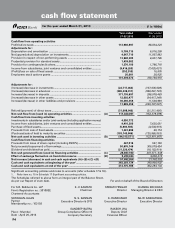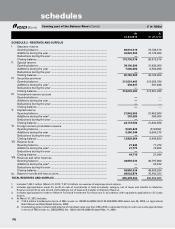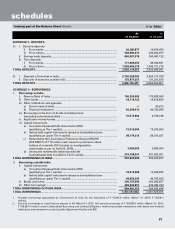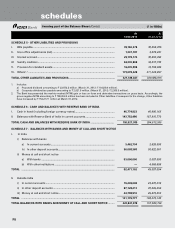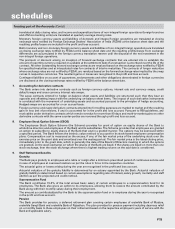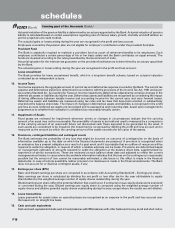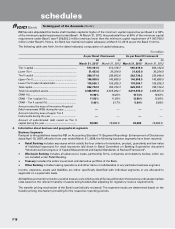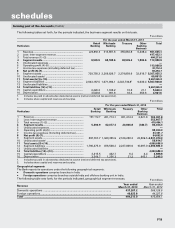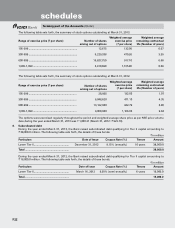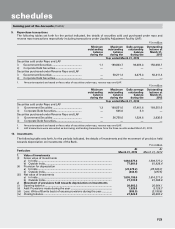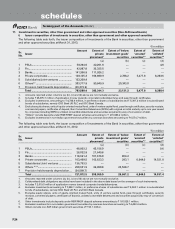ICICI Bank 2013 Annual Report Download - page 92
Download and view the complete annual report
Please find page 92 of the 2013 ICICI Bank annual report below. You can navigate through the pages in the report by either clicking on the pages listed below, or by using the keyword search tool below to find specific information within the annual report.
F14
In respect of non-performing loans and advances accounts subjected to restructuring, the account is upgraded to
standard only after the specified period i.e. a period of one year after the date when first payment of interest or of
principal, whichever is earlier, falls due, subject to satisfactory performance of the account during the period.
c) Amounts recovered against debts written-off in earlier years and provisions no longer considered necessary in the
context of the current status of the borrower are recognised in the profit and loss account.
d) In addition to the specific provision on NPAs, the Bank maintains a general provision on performing loans and
advances at rates prescribed by RBI. For performing loans and advances in overseas branches, the general provision
is made at higher of host country regulations requirement and RBI requirement.
e) In addition to the provisions required to be held according to the asset classification status, provisions are held for
individual country exposures including indirect country risk (other than for home country exposure). The countries
are categorised into seven risk categories namely insignificant, low, moderate, high, very high, restricted and off-
credit and provisioning is made on exposures exceeding 180 days on a graded scale ranging from 0.25% to 100%.
For exposures with contractual maturity of less than 180 days, provision is required to be held at 25% of the rates
applicable to exposures exceeding 180 days. The indirect exposures will be reckoned at 50% of the exposure. If the
country exposure (net) of the Bank in respect of each country does not exceed 1% of the total funded assets, no
provision is required on such country exposure.
4. Transfer and servicing of assets
The Bank transfers commercial and consumer loans through securitisation transactions. The transferred loans are
de-recognised and gains/losses are accounted for only if the Bank surrenders the rights to benefits specified in the
underlying securitised loan contract. Recourse and servicing obligations are accounted for net of provisions.
In accordance with the RBI guidelines for securitisation of standard assets, with effect from February 1, 2006, the Bank
accounts for any loss arising from securitisation immediately at the time of sale and the profit/premium arising from
securitisation is amortised over the life of the securities issued or to be issued by the special purpose vehicle to which
the assets are sold. In the case of loans sold to an asset reconstruction company, the excess provision is not reversed
but is utilised to meet the shortfall/loss on account of sale of other financial assets to securitisation company (SC)/
reconstruction company (RC).
In accordance with the RBI guidelines dated May 7, 2012 for securitisation of standard assets, with effect from May 7,
2012, the Bank accounts for any loss arising from securitisation immediately at the time of sale and the profit/premium
arising from securitisation is amortised over the life of the transaction based on the method prescribed by RBI guidelines.
5. Fixed assets and depreciation
Premises and other fixed assets are carried at cost less accumulated depreciation. Cost includes freight, duties, taxes and
incidental expenses related to the acquisition and installation of the asset. Depreciation is charged over the estimated
useful life of a fixed asset on a straight-line basis. The rates of depreciation for fixed assets, which are not lower than the
rates prescribed in Schedule XIV of the Companies Act, 1956, are given below.
Asset Depreciation Rate
Premises owned by the Bank 1.63%
Improvements to leasehold premises 1.63% or over the lease period, whichever is higher
ATMs 12.50%
Plant and machinery like air conditioners, photo-copying
machines, etc. 10.00%
Computers 33.33%
Furniture and fixtures 15.00%
Motor vehicles 20.00%
Others (including Software and system development expenses) 25.00%
a. Depreciation on leased assets and leasehold improvements is recognised on a straight-line basis using rates
determined with reference to the primary period of lease or rates specified in Schedule XIV to the Companies Act,
1956, whichever is higher.
b. Assets purchased/sold during the year are depreciated on a pro-rata basis for the actual number of days the asset
has been put to use.
c. Items costing upto ` 5,000/- are depreciated fully over a period of 12 months from the date of purchase.
d. Assets at residences of Bank’s employees are depreciated at 20% per annum.
e. In case of revalued/impaired assets, depreciation is provided over the remaining useful life of the assets with
reference to revised assets values.
6. Transactions involving foreign exchange
Foreign currency income and expenditure items of domestic operations are translated at the exchange rates prevailing
on the date of the transaction. Income and expenditure items of integral foreign operations (representative offices) are
forming part of the Accounts (Contd.)
schedules


